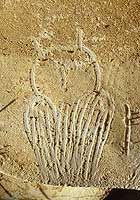
Plate 2
|

Plate 3
|
|
An Owl as Cave Art
Art
In 1994 news of the discovery of Chauvet Cave in France and its walls full of Paleolithic art spread rapidly, and photographs of the woolly rhinoceroses, lions, bears and other animals, including this owl, were almost immediately available to accompany the early reports. Photographs of the owl were not as widely circulated as were those of the grotto’s megafauna, but Paleolithic bird images were not as widely produced as the megafauna were, either. Years earlier, André Leroi-Gourhan (1911–1986), former director of the Museé de l’Homme in Paris, had surveyed seventy-two caves in France and neighboring countries and listed over 2,000 animal images on the walls. Among them, horse images outnumbered the rest, with 610; bison followed with 510; and mammoths came in a distant third with 205. Fish accounted for a paltry 8, and birds (or their heads) for only 6 (2 in Lascaux, 4 in Les Trois Frères).[3]
The official cave Web site describes the Chauvet owl image as follows: “This finger tracing represents an owl. The position of the wings shows that its head is turned 180 degrees relative to its posterior face. The anatomical characteristics of the animal permit its attribution to Moyen Duc [Long-eared Owl] (Asio otus). This drawing was realized on the soft outer layer of the cave wall. In the background we see traces that show the wall surface was scraped before the drawing was made.”[4]
page 2--> |
Plate 2 Owl in Chauvet Cave, Vallon–Pont d'Arc, France,
c.30,000 BCE
Plate 3 Modified Owl in Chauvet Cave, Vallon–Pont d'Arc, France, 1997/2007 (Eagle Owl) by Darryl Wheye
© 2008 Darryl Wheye and Donald Kennedy
|


